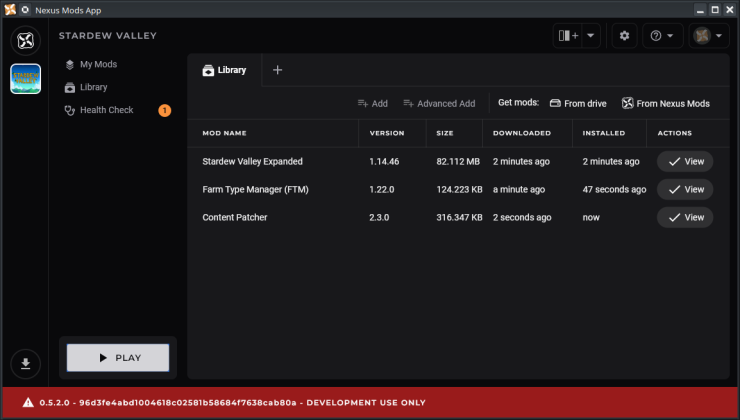Yesterday, July 1st, they announced the Alpha release of this next-generation mod manager and their new Product Manager got in touch to mention they “would be really keen to get feedback from Linux users”. So this is your chance to ensure Linux (and Steam Deck) finally become a first-class citizen for game modding.



Mind if we collectively do some troubleshooting?
What are you using to write to the usb key? Have you tried tools like Ventoy? What OS are you using to write the USB iso? Which iso are you using?
What model is your laptop? How far along in the process are you able to get? Is the USB key in the boot device list? Do you have USB enabled in the BIOS under bootable options?
I would really appreciate that in fact.
I tried Rufus and UNetbootin, both on the windows 10 machine I’m intending to try Linux on, to a 32gb flash drive (I tried two different ones actually). I used an AV Linux ISO and Ubuntu Studio ISO. I have not tried Ventoy.
It’s an HP. I’ll have to check the model. I went through the bios, and while admittedly it’s been some time, I thought everything seemed right. I recall trying to change the priority.
It wouldn’t boot at all. Windows just forces its way through.
Edit: I looked I to Ventoy a bit. I’ll give it a try tomorrow.
There should be a a button that you can press repeatedly to open up a boot menu - it can be the delete key, f2, etc.
Depending on how new your laptop is, you may need to disable something called “Secure Boot”. Keep in mind if your windows installation is encrypted with BitLocker or whatever else Windows is using these days. If it is encrypted, and you have secure boot enabled you may run into issues booting back into Windows - it will freak out that secure boot was disabled and require your encryption key.
At least, that’s what happened with my ROG Zephyrus M16 - I had to find my BitLocker key to boot into Windows and then decrypt it using the settings menu.
Also, if you want to be able to use both Windows and Linux - see if your laptop has an expansion port for a second hard drive. Windows historically has screwed over dual booted Linux grub with updates, and if you can just boot to a entirely different drive that won’t happen.
It’s at least 5 years old. I’ll look into secure boot. I wouldn’t be against ditching windows entirely but I’m not sure I’m up for transferring all my files over right now. No way my laptop supports another drive unfortunately
Edit: however much to my surprise I did find an official service guide
Yeah, I may catch flak but I wouldn’t be inclined to ditch windows altogether. Unless you literally only do web browsing on your laptop, there’s a high likelihood you may run into a few things that need troubleshooting to get working under Linux, and dual being able to switch back to Windows seamlessly is a huge help/comfort.
If you can find the model number or service tag, that would be a big help for troubleshooting.
There should be a sticker under your laptop with a bunch of tiny text, or if I recall correctly you can use System Information. See this article
That’s good advice, but I’d put forward that you can do all your troubleshooting in a live install so you can bail if you need to. Chances are most things just work and then it’s easier to hit the button.
I only do audio production on my laptop. All browsing is come on my phone whenever possible. The software in my workflow is all Linux compatible and the distros I’m interested in are geared toward that focus. That said I would appreciate the convenience of having windows for now still. Especially since there are some plugins I occasionally use which unfortunately aren’t Linux compatible.
UNetbootin stopped being useful a long time ago. Rufus is OK as long as you set it up right.
Partition scheme: MBR
Target system: BIOS or UEFI
File system:FAT32
Then in the BIOs setting on the HP go to advanced and set “Legacy Support Enabled”. Save and exit.
Smash the F9 key repeatedly during boot to pull up the boot menu. You should see your USB device listed to pick and boot from.
I feel like those were the settings I used in Rufus. Sounds like legacy support might be what I need, thanks.
@w2tpmf @can What about #Ventoy https://ventoy.net/en/index.html ?
Ventoy is great, but…
It takes a few more steps to setup than Rufus, and you still have to set the right boot mode
The tool OP already has should work so there’s no need to send him to download another piece of software if he can complete the task with what he has.
@w2tpmf ventoy is as easy to set up as any other Boot-Stick-tool and has the great advantage that you can copy as many ISOs on your stick as there is space and you can still use it for other files… imho
I know exactly how it works. I use it every day. I never said it isnt easy. I said it’s more steps to set it up.
Rufus: run exe, pick iso, run it
Ventoy: run exe to install it, run it to configure the drive, copy ISOs over to the drive
For setting up a drive that’s going to be used repeatedly and continually changing what’s on it, Ventoy is the superior tool.
For a one time use to quickly get a ISO over to a USB… Rufus is quicker and gets the job done.
…and again…OP already has Rufus in hand. There’s no reason to get another piece of software that doesn’t offer any advantage to OP’s task.
To prove your point, ventoy seems to come with 3 .exes
@w2tpmf Ventoy is a one time setup. After that you can throw any ISO on it and just reboot…
But you are right and we are on the same boat :mastolove:
I literally just wrote out how it works and you are repeating it back like it’s new information 😆